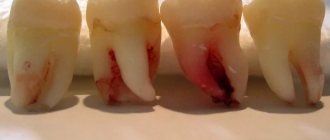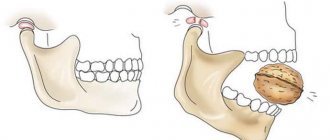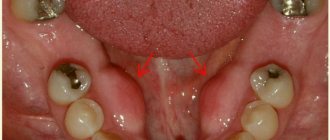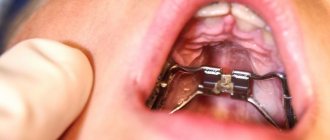Dentists recommend undergoing preventive dental examinations at least once a year. This helps keep teeth healthy and avoid various complications. Due to lack of time and fear, patients come to the dental office only after pain appears.
Missing timely treatment can lead to protracted complex treatment or tooth extraction. These are not all the consequences that patients may face. Often during dental procedures, soft tissues are damaged and an inflammatory process occurs. Thus, a frequent complication is gumboil after tooth extraction.
Flux is a purulent inflammatory process in the soft tissues of the gums . The disease requires urgent and serious treatment measures. However, there is no need to panic; timely correct actions help to quickly and effectively cope with the disease.
Causes of flux after extraction
In dentistry, gumboil refers to an inflammatory process that forms inside soft tissues and manifests itself in the form of swelling, purulent discharge, fever and other unpleasant syndromes. The medical term is periostitis. There is only one mechanism for the development of flux: pathogenic bacteria provoke the development of infection, which penetrates into the gums and periosteum through microtubules.
Dangerous symptoms!
- Deep inflammatory process.
- Invasive tooth extraction, after which the gums are injured. If additional anti-inflammatory therapy is not given, infection may develop.
- Poor-quality temporary prosthesis, which caused gum injury and infection.
- Dry socket syndrome.
A simple type of flux
Also, the duration of the disease depends on its type. Simple flux lasts about a week and appears under the influence of two reasons:
- injuries;
- inflammatory processes near the periosteum.
The problem can appear even after a simple bruise. Usually the area of the periosteum, which is covered with a thin layer of tissue, is affected. On the first day after the inflammation appears, a person feels discomfort in the jaw. During the examination, slight swelling of the soft tissues and pain during palpation of the gums are revealed.
We invite you to read 6 warnings for those who want to fluoride their teeth at home
Simple flux responds well to treatment. If you immediately consult a doctor, then within 2-3 days after the start of drug therapy you will be able to reduce discomfort, and after 7-8 days you will be able to stop the inflammation.
How long does the flux last after tooth extraction?
Many patients wonder why the flux does not go away after tooth extraction. The answer to this question is obvious: if the infection has penetrated deep into the tissue and an inflammatory process has developed, tooth extraction is unlikely to stop it. If the pathology arose immediately after extraction, then you should not expect that the problem will disappear on its own. Of course, there are situations when the initial inflammation goes away due to the protective properties of the body. However, gumboil is a result, not a start, so it practically cannot disappear on its own, even if it breaks through on its own and some of the pus comes out. Moreover, neglected periostitis develops into an abscess and phlegmon, which are even more difficult to cure. The most serious consequences of flux are blood poisoning and death, which often happened in the past when medicine did not have effective treatment methods.
What kind of disease is this
In this article we will talk about flux: how long it lasts, what types there are, what the result of treatment depends on. To begin with, it is worth saying that the disease appears due to inflammatory processes in the gum pockets, complications of cysts and stomatitis, and untreated caries. Also, the problem often occurs after a jaw injury. An infection penetrates into the pulp, which becomes a catalyst for the disease.
If the inflammation is not treated, it will actively develop and end up beyond the boundaries of the pulp. The result will be inflammation of the apex of the tooth root. After this, an abscess will appear in the form of a purulent capsule. Due to the penetration of pus, the gums will begin to swell, which leads to swelling of the facial tissues.
During periostitis, a person feels severe pain in the teeth, which becomes stronger while chewing food. The temperature rises, general health worsens.
A neglected cyst can lead to the formation of a lump on the gum
Periostitis will not go away on its own. Moreover, if the disease persists for a long time without proper treatment, blood poisoning may begin, which often leads to death.
Swelling, temperature and other symptoms
The main symptom by which flux can be visually identified is a soft tissue tumor and a characteristic purulent sac that forms during the development of the pathology. Over time, the clinical picture worsens. For example, huge tumors on the gums and cheeks are the result of severe periostitis. One of the characteristic symptoms of flux is severe pain that spreads over a large area of the jaw, and also radiates to the ears, neck and other parts of the head. The temperature after removal of a tooth with flux (if it is preserved) is usually consistently high (from 38 degrees), but in some situations the body temperature does not go beyond normal levels. The film covering the hole becomes brown or grayish in color, and bad breath appears. Read about complications after tooth extraction in the article.
Attention!
It is important to understand that tooth extraction is a surgical procedure. Inflammation, minor bleeding and pain are quite common. These symptoms should completely subside within a few days. If the pain lasts more than five days, and the above-mentioned manifestations of flux also occur, you should consult your doctor.
What do experts think?
When patients ask their doctors how many days it should take for the flux to disappear, experts talk about 1-3 weeks. However, to do this, several important conditions must be met.
First of all, you should visit your doctor regularly and follow all his recommendations. In addition, you need to adhere to the correct treatment regimen and purchase only certified medications from pharmacies.
But even compliance with the above requirements does not guarantee that flux manifestations will disappear after 2 weeks. It is impossible to say exactly how many days periostitis lasts. We can only talk about approximate dates, since they are influenced by the individual characteristics of the body, immunity, type of disease and treatment. Let's look at this in more detail.
Treatment of flux after tooth extraction
Flux occurs after tooth extraction: what to do? Firstly, you should not delay your visit to the dentist. The sooner you start treatment, the higher the chances of a speedy recovery. The doctor will quickly make a diagnosis and draw up an optimal rehabilitation plan. The method of treating flux after tooth extraction depends on the severity of the pathology.
Conservative
Treatment is carried out with antibiotics that suppress the activity of bacteria. Antibiotics after tooth extraction with flux: Lincomycin; Ciprofloxacin, Amoxiclav and their broad-spectrum analogues
Along with antibiotics, anti-inflammatory and painkillers are prescribed (Nimesil Diclofenac, Ketanov, etc.). Metrogyl Denta and Levomekol ointments help to cope with inflammation. After tooth extraction with flux, to clean and protect the oral cavity, regular rinsing with a solution of Chlorhexidine, Miramistin or soda is required (if there is no access to the first two drugs).
Attention!
Consultation with the body is required before use.
Surgical
If the flux is at an advanced stage and a purulent sac has formed, the most effective measure is surgery. This procedure is called periostotomy. The dental surgeon makes an incision in the area of inflammation, after which he installs a special drainage to drain the pus. When the swelling subsides and all the pus comes out, the patient is given stitches. Surgical treatment does not exclude the use of antibiotics and other anti-inflammatory and antiseptic agents described above.
What to do if it doesn't work
At home, you should perform several procedures that will relieve swelling and prevent further development of gumboil:
- Applying cold throughout the day after root canal treatment or tooth extraction will help reduce pain The procedure is performed every half hour. A heating pad with ice or a bottle of water is suitable for these purposes.
- To speed up the drainage of fluid from the problem area, it is recommended to sleep at night with your head slightly elevated.
- Relieving swelling is possible with the help of medications. Drugs with antihistamine properties have a positive effect.
- Monitor blood pressure. Exceeding its norm will cause strong pulsation and increased pain.
It is important to maintain oral hygiene. After eating, it is necessary to rinse with a solution containing chlorhexidine.
Recommendations for treatment and prevention
How long does the flux last after tooth extraction if treatment is started in a timely manner? In the early stage, symptoms disappear within two to three days. In severe forms (large purulent gum after tooth extraction), when surgical intervention is required, rehabilitation takes longer and takes up to several weeks. What is important is how the patient follows the doctor’s recommendations and what measures he takes to speed up recovery.
Prohibited!
- self-medicate and self-prescribe antibiotics;
- apply warm compresses and use warming ointments, as this promotes the growth of bacteria;
- take aspirin before surgery, as it thins the blood;
- During the recovery process, active physical activity, going to the sauna and swimming pool are prohibited (even when the jaw no longer hurts).
Flux after wisdom tooth removal occurs much more often, since the procedure for removing “eights” is usually very traumatic, which affects the condition of the soft tissues. After the removal of wisdom teeth, you need to especially carefully monitor your condition and take all necessary preventive measures to minimize the risk of developing periostitis.
Rinse
Mouth rinsing is one of the answers to the question of how to remove gumboil at home. For this purpose, various decoctions, tinctures and medicinal solutions are used. Before using any mouthwash, you should consult your doctor.
Let's look at the most effective types of solutions that can be used to remove flux by rinsing:
- Oak bark. A freshly prepared decoction based on oak bark works well as an excellent mouth rinse for flux. To prepare this product, you must purchase at least twenty grams of dry oak bark. You can stock up on it in the summer or purchase it at the pharmacy. Measure out about twenty grams of dry and pre-crushed oak bark and pour half a liter of boiling water. Everything is put on fire and boiled for two minutes, and then put in a secluded place to infuse. It is recommended to rinse your mouth with cooled oak broth at least eight times a day;
- Calamus root. Effective in the fight against gumboil and its manifestations. After grinding twenty grams of dried calamus root, pour half a liter of hot water. Everything is removed for several hours to infuse and cool. It is recommended to rinse your mouth with calamus root after meals throughout the day. On average, the number of rinses should not be less than five times per day. The last time this rinse is recommended is before bedtime;
- Rue decoction. For flux, you can use a decoction based on rue. You need to stock up on a small amount of this herb and brew it in a glass of boiling water. After steeping for twenty minutes, it is recommended to strain the broth. It is necessary to rinse the inflamed gum with this decoction three times a day;
- Soda-saline solution. You can get rid of flux using a soda-salt solution. Place a teaspoon of soda and salt into a clean container, and then pour a glass of warm water into it. Mix everything thoroughly until the soda and salt are completely dissolved. The resulting solution must be cooled and only then used as a rinse. It is necessary to rinse the flux every thirty minutes, regardless of food intake. The active components of the soda-saline solution accelerate the maturation of the abscess and help relieve pain;
- Herbal collection. To prepare this effective remedy for pain caused by flux, brew sixty grams of the following herbs with pre-boiled purified water: periwinkle, angelica, peppermint and birch buds. The resulting solution should be placed in a dark place for several hours to infuse. After three hours, the herbal mixture can be used as an excellent rinse. During the day, it is recommended to rinse your mouth with this herbal mixture at least six times. This remedy is infused not only with water, but also with vodka. It is enough to take it in the amount of eight hundred grams;
- Chlorophyllipt solution. Using a chlorophyllipt solution, you can not only relieve pain from flux, but also help eliminate it. The antiseptic properties of this substance have been known for decades. To prepare such a solution at home, take a glass of boiled water and dissolve a tablespoon of chlorophyllipt in it. The drug is diluted with thorough mixing, and only then used to rinse the mouth.
We invite you to familiarize yourself with Large papillae on the tongue. Enlarged papillae on the tongue
We suggest you read: What to do if your tooth is cracked
How to remove flux quickly at home? Thanks to medicinal compresses, you can kill numerous pathogenic organisms that have entered the body in a short time. Compresses also help to cope with the pain of flux and relieve the inflammatory process that has begun.
How to treat gumboil on the cheek
Treatment of flux in adults and children is the same. The dentist makes a diagnosis and determines the stage of development of the pathology:
- Early. At this stage, there is no abscess yet, and the doctor prescribes drug treatment. Toothache due to gumboil is treated with painkillers, and antibiotics are prescribed to relieve inflammation. Rinsing with antibacterial drugs stops the growth of pathogenic bacteria and has an anti-inflammatory effect.
- Purulent. In the acute stage, surgical treatment of the flux is performed.
We invite you to familiarize yourself with Yellow tongue and bitterness in the mouth
Removal of flux, stages of surgical treatment:
- The dentist administers an anesthetic.
- An incision is made in the gum to drain the pus out.
- Washing with antiseptics.
- Drainage. A rubber strip is placed into the incision on the gum to prevent the incision from healing quickly and to close the exit of accumulated pus.
- Prescribing a course of antibiotics.
- Removing drainage. After all the pus has come out of the cavity, the drainage is removed and the incision heals on its own. In rare cases, the gum is sutured.
- Removing a diseased tooth. Whether it is possible to cure a tooth rather than remove it is up to the dentist to decide.
Sometimes the tooth is removed immediately, without waiting for the swelling to subside and the inflammation to stop. Treatment and prescribed medications in each specific case will be different, depending on the stage of the pathology and the characteristics of the patient’s body.
Important!
Do not remove the drainage strip ahead of schedule - the incision quickly heals and pus again accumulates in the cavity. If your drain falls out, contact your dentist immediately.
Treatment for delays in seeing a doctor
The next stage of the flux will be the formation of abscesses, which can break out in advance, but more often they are removed surgically. In this case, the dentist makes an incision in the gum, releasing the pus out, after which everything is processed and bacterialized. It is necessary to completely eliminate the formation of residual pus, otherwise the inflammation will continue. The doctor uses a special drainage to remove pus, in which a rubber strip is inserted into the abscess. The outflow of pus from the infected canal will pass through it. Eliminating the causes of gumboil in a complicated form involves surgical intervention, so only competent, professional, reputable doctors should work to eliminate the disease. If the removal of pus is carried out incorrectly, which leads to re-inflammation, exacerbation of pain, and an abscess, then repeated intervention by doctors will be inevitable. And this, in turn, will incur additional inconvenience in that the patient will have to re-experience all the delights of surgical intervention in his mouth.
Symptoms of the disease
The flux will not let you be indifferent to its appearance; the sharp pain, especially when pressing on the tooth, will not allow you to sit still for a long time. A swelling will appear in the affected area, which will be visually clearly visible. The patient will experience malaise, weakness, and the body temperature may rise. On palpation, enlarged lymph nodes will be felt. As the disease develops, it will become painful to swallow, which will cause serious problems when eating and drinking. Opening your mouth will be difficult and painful. This is the main set of symptoms, the manifestation of which should immediately contact a dentist, resorting to emergency treatment.
Causes of periostitis
Experts explain the occurrence of flux by the activation of pathological microflora, which is in a dormant state. The main risk factors include:
- complex and traumatic tooth extraction;
- incomplete extraction of the root from the bone tissue;
- atraumatic surgery for tooth root extraction.
In most cases, the disease develops after the spread of purulent infection from the periodontal gap of the causative tooth into nearby bone tissue.










